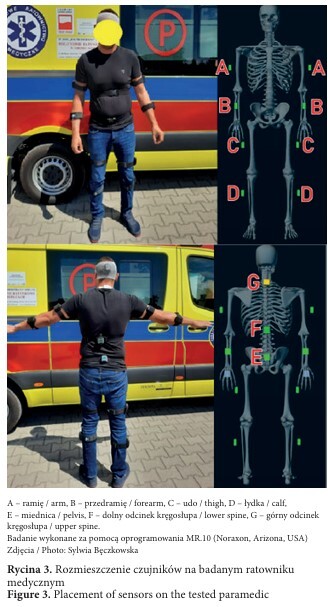Online first
Current issue
Archive
Most cited in 2024
About the Journal
Editorial Office
Editorial Board
Copyright and self-archiving policy
Information clause on the processing of personal data
Declaration of accessibility
Instructions for Authors
Instructions for Reviewers
Contact
Reviewers
2024
2023
2022
2020
2021
2019
2018
2017
2016
2015
2014
2013
Editing and translations
ORIGINAL PAPER
(Un)ergonomic working conditions for a paramedic in a medical ambulance
1
Politechnika Warszawska / Warsaw University of Technology, Warsaw, Poland
(Wydział Transportu / Faculty of Transport)
2
Warszawski Uniwersytet Medyczny / Medical University of Warsaw, Warsaw, Poland
(Zakład Ratownictwa Medycznego / Department of Emergency Medicine)
Online publication date: 2024-03-12
Corresponding author
Med Pr Work Health Saf. 2024;75(1):31-44
KEYWORDS
TOPICS
ABSTRACT
Background: The work of a paramedic, is characterised by a high risk of injury. Ergonomic, psychological, and biomechanical factors are considered risk factors in the profession of emergency medical technicians. Ensuring ergonomic working conditions for emergency medical technicians is a priority and requires a thorough assessment both in the design process and during the operation of the ambulance, to provide a diagnosis of the current state and present necessary recommendations for modernization. Identifying stressors will enable the design of an ergonomic interior for the ambulance, ensuring comfort and reliability for members of the emergency medical team, thereby reducing the risk of injuries. Material and Methods: The authors of this article developed a comprehensive methodology for assessing the nuisances occurring during the paramedic’s work, which required specialised preliminary research. The research included the measurement and analysis of the paramedic’s movement kinematics during typical medical procedures, both at a standstill and while driving the ambulance. For the analysis of motion kinematics, a non-invasive method called myoMotion was employed, and the study was conducted in a Mercedes ambulance. Results: This article contains preliminary results on the evaluation of movement kinematics. These demonstrated the necessity for the paramedic to adopt forced positions when performing medical procedures. The ranges of movement of the individual body parts of the paramedic deviated from accepted norms, resulting in musculoskeletal overload. Conclusions: The acquired knowledge forms the basis for a detailed analysis of tasks performed within each procedure from the perspective of the spatial structure of the ambulance, the arrangement of equipment and medical supplies, their accessibility during work, and the organization of work within the ambulance. Additional identification of musculoskeletal system stress, its sources, and the formulation of modification recommendations for the ambulance interior will enable ensuring the comfort and reliability of the work for emergency medical teams, thereby reducing the risk of injuries in the workplace. Med Pr Work Health Saf. 2024;75(1):31–44
Share
RELATED ARTICLE
We process personal data collected when visiting the website. The function of obtaining information about users and their behavior is carried out by voluntarily entered information in forms and saving cookies in end devices. Data, including cookies, are used to provide services, improve the user experience and to analyze the traffic in accordance with the Privacy policy. Data are also collected and processed by Google Analytics tool (more).
You can change cookies settings in your browser. Restricted use of cookies in the browser configuration may affect some functionalities of the website.
You can change cookies settings in your browser. Restricted use of cookies in the browser configuration may affect some functionalities of the website.






